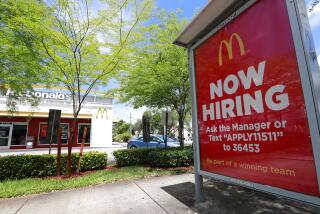Wal-Mart’s raise underscores the poor condition of most low-wage workers

- Share via
Before we all jump for joy at Wal-Mart’s announcement Thursday that it’s raising the pay of 500,000 employees, let’s place it in perspective.
Wages for Wal-Mart’s lowest-paid employees have long been a national scandal. In 2009, Ohio officials disclosed that more than 15,200 Wal-Mart employees in the state were receiving Medicaid, and 12,700 were on food stamps. Wal-Mart topped the list of Ohio employers with employees in both programs.
When a company executive disclosed in 2013, with some pride, that more than 475,000 of its employees earned more than $25,000 a year, it wasn’t lost on many observers that the figure implied that a half-million might be earning wages at or below the federal poverty level for a family of four.
Wal-Mart’s new wage regime will raise minimum starting pay to $9 an hour beginning this April--why not start tomorrow?--and $10 an hour as of February 2016. The company says that raises all along the hourly wage ladder will bring the average for part-timers to $10 in April.
That’s an improvement. But the average nationwide minimum will barely keep pace with statutory minimum wages now or going into effect in January in nine states and the District of Columbia, including California (where the minimum will rise to $10 on Jan. 1.)
The Wal-Mart minimums will be higher than the federal minimum wage of $7.25. But that’s a pathetically low benchmark. The federal minimum, which applies where state minimums are lower, hasn’t been raised since 2009. And it isn’t nearly what it used to be. In terms of buying power, the federal minimum wage peaked in 1968, when it was nominally $1.60 an hour. That would be the equivalent of $10.88 today.
To put it another way, Wal-Mart employees receiving the company minimum even next year will still be earning less in real terms than the minimum wage nearly a half-century ago. To call that “progress” requires stretching the definition of the term beyond the breaking point.
Wal-Mart’s initiative underscores how badly workers have been doing in general. Figures from the Economic Policy Institute--released, fortuitously, around the same time as Wal-Mart’s announcement--demonstrated that hourly wages fell again from 2013 to 2014 for almost all workers. One of the few exceptions was for workers in the bottom 10%. The reason? Increases in the minimum wage in states and cities that 47.2% of U.S. workers call home. (See accompanying map.)
The only group in the EPI survey that has experienced an increase in hourly wages since the 2008 recession is the top 5%. (See graph.) Other than an uptick in real wages for everyone during 2008, thanks to negative inflation that year, for everyone else the story has been down, down, down.
EPI Research Director Josh Bivens is justified in observing that excitement over Wal-Mart’s announcement “just highlights how beaten down expectations about wage growth in the U.S. economy have become.” Rising wages, he says, should be happening across the board, “without fanfare.” Plainly we have a long way to go before economic gains are fairly distributed.
That brings us to the question of what motivated Wal-Mart’s action.
Some of it is obviously PR. The company has become the poster child for cheeseparing retail employers, with good reason. Possibly members of the Walton family, who are its majority shareholders, got tired of hearing questions about why a company that recorded profits of nearly $16 billion and upstreamed $13 billion to shareholders in the form of dividends and share repurchases in 2014 couldn’t keep more of its loyal workers out of poverty row and off public assistance.
Wal-Mart may also have come around to the realization that cutting costs by squeezing its workers and reducing the workforces at its stores was a losing proposition, competitively. In 2013 the grimy condition of its stores, their unstocked shelves, and the lengthening of their checkout lines reached a crisis, and customers started to flee. The firm had reduced its payroll by 120,000 persons since 2008, despite opening hundreds of new stores. Employment started to creep back up.
Counterexamples abound. Wal-Mart’s retail rivals such as Costco and Trader Joe’s have maintained their margins and kept customers happy while keeping workers happy with decent wages and humane labor policies. Gap and Ikea have beaten Wal-Mart to getting religion on wage-raising. (Thursday’s announcement includes an initiative to arrange work schedules with more sensitivity.)
It may also be true that labor markets are finally tightening to the point that companies like Wal-Mart feel they have to bid up to attract and retain workers. If that’s so, we’re still at the very beginning of the curve. Wal-Mart’s action looks like a halting step in the right direction, but still only a first step.
Keep up to date with the Economy Hub. Follow @hiltzikm on Twitter, see our Facebook page, or email [email protected].
More to Read
Inside the business of entertainment
The Wide Shot brings you news, analysis and insights on everything from streaming wars to production — and what it all means for the future.
You may occasionally receive promotional content from the Los Angeles Times.











